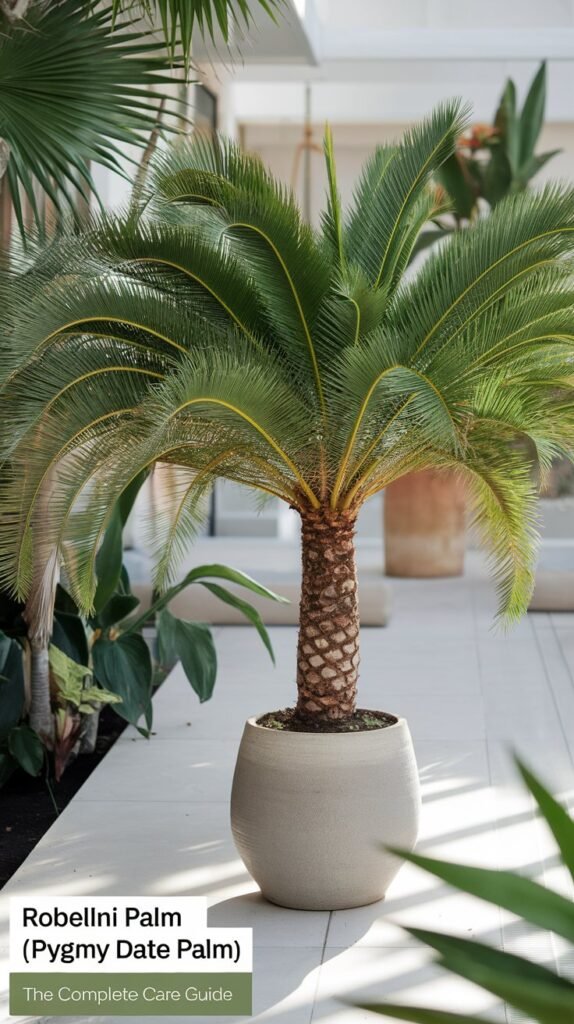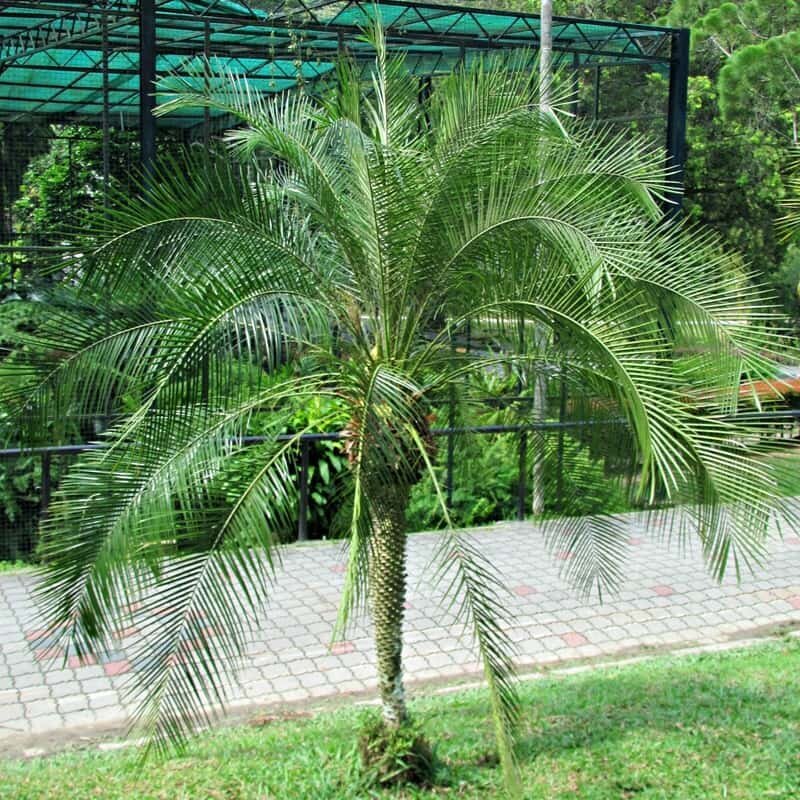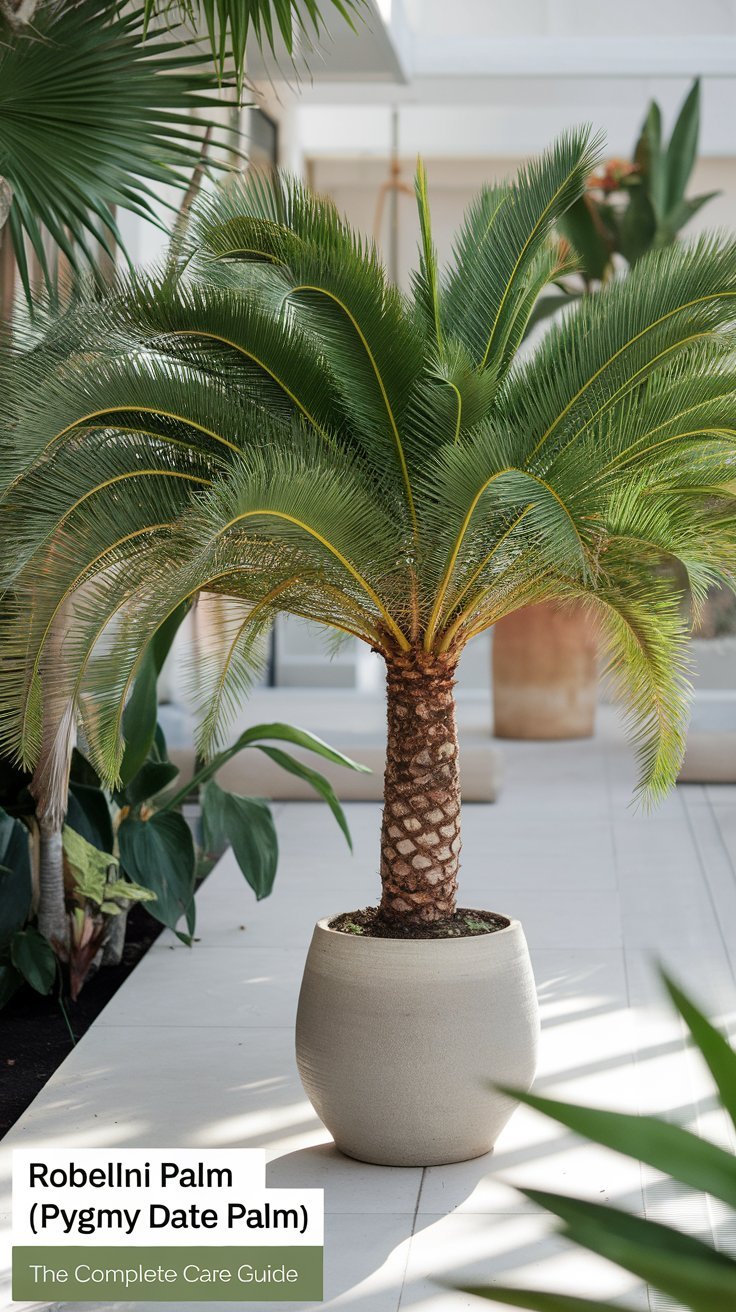Discover all about the robellini palm—its looks, care tips, and how to trim it. Learn why this pygmy date palm is perfect for any USA home or garden.

Have you ever dreamed of turning your backyard into a tropical oasis? I know I did when I started gardening over 10 years ago. That’s when I discovered the robellini palm, a compact, stunning little tree that brings a slice of paradise right to your doorstep. Known also as the pygmy date palm or Phoenix roebelenii, this palm has become one of my favorites to grow and care for. In this guide, I’ll share everything I’ve learned about the robellini palm—from its lush looks to practical care tips—so you can enjoy it too, whether you’re in Florida or tending it indoors in a cooler state.
What Exactly Is a Robellini Palm?

Let’s start with the basics. The robellini palm is a small, slow-growing palm tree native to Southeast Asia. Its scientific name, Phoenix roebelenii, might sound fancy, but don’t let that intimidate you—it’s super approachable! Often called the pygmy date palm, it’s a go-to for homeowners and gardeners across the USA because of its manageable size and tropical vibe. I’ve got one in a pot on my patio, and it’s been a conversation starter at every barbecue.
This palm typically grows to about 6-12 feet tall with a spread of 6-8 feet, making it perfect for small yards, patios, or even as an indoor plant. Its slender trunk has a cool diamond pattern, and the feathery, bright green fronds give it that classic palm tree look. In spring, it sprouts tiny white flowers, and by fall, you might spot small black fruits—though don’t expect edible dates like its bigger cousins!
Why I Love the Robellini Palm: Its Standout Features
Appearance That Wows
Picture this: a petite palm with arching fronds that sway gently in the breeze. That’s the robellini palm tree for you. It’s not just its size—topping out at 12 feet—that makes it special. The vibrant green leaves and textured trunk add a decorative touch to any space. I’ve used mine to frame my garden walkway, and it’s like having a mini tropical getaway every time I step outside.
Slow and Steady Growth
One thing I adore about robellini palms is their slow growth. Unlike some plants that shoot up overnight and demand constant trimming, this one takes its time. That makes it ideal for containers or tight spaces. My first pygmy date palm took years to reach 8 feet, and I loved watching it grow without feeling rushed to manage it.
Indoor or Outdoor Versatility
Living in the USA, where climates vary wildly, I appreciate how adaptable robellini palm trees are. In warm states like California or Texas, they thrive outdoors. Up north, I bring mine inside during winter, and it still looks fabulous by a sunny window. It’s a win-win for any gardener!
How to Care for Your Robellini Palm: My Tried-and-True Tips
Caring for a robellini palm is easier than you might think. After a decade of tending to these beauties, here’s what I’ve found works best:
Watering: Keep It Balanced
Water your robellini palm regularly, but don’t drown it. I aim for moist soil—not soggy. In summer, I water mine every few days, letting the top inch dry out between sessions. Indoors, I cut back a bit, checking the soil with my finger. Overwatering is the fastest way to upset this palm, so trust me—less is often more!
Fertilizing: Feed It Right
During spring and summer, I give my pygmy date palm a balanced fertilizer—like a 10-10-10 mix. Once a month keeps it happy and green. Skip the fertilizer in fall and winter; it’s resting then, and I don’t want to overwhelm it.
Sunlight: Bright but Not Brutal
These palms love bright, indirect light. Outdoors, I place mine where it gets morning sun and afternoon shade—too much direct heat can scorch the fronds. Indoors, a spot near an east-facing window has worked wonders for me.
For more general palm care tips, check out my guide on How to Care for Palm Trees over at USA Garden Hub.
How to Trim a Robellini Palm: A Step-by-Step Guide
Trimming a robellini palm tree is something I get asked about a lot, so let me break it down. It’s simple once you know the ropes!
- Timing Is Key: I trim mine in spring or early summer when it’s growing strong. Avoid winter—it’s too stressful for the plant.
- Grab the Right Tools: I use sharp pruning shears or a small pruning saw. Clean them first to avoid spreading disease.
- Focus on Dead Fronds: Look for yellow or brown fronds—these are the ones to cut. I snip them close to the trunk but never nick the trunk itself.
- Don’t Overdo It: Less is more here. I only remove what’s dead or damaged to keep the palm healthy and looking natural.
Wondering why trimming matters? It keeps your robellini palm looking tidy and encourages new growth. Plus, it prevents pests from setting up shop in dead leaves.
Answering Your Top Robellini Palm Questions
Over the years, I’ve heard these questions pop up again and again, so let’s tackle them:
Are Robellini Palms Cold Hardy?
Not really. Robellini palms can handle a light chill—down to about 30°F—but anything colder spells trouble. I learned this the hard way when a surprise frost hit, and I had to rush my potted palm indoors. If you’re in a colder part of the USA, grow it in a container and bring it inside during winter.
Are Robellini Palms Poisonous?
Good news: robellini palms aren’t toxic to humans or pets. That said, the fronds can be a bit prickly, so I wear gloves when trimming to avoid irritation. My dog once chewed a leaf with no issues, but I still keep him away just to be safe.
How Fast Do Pygmy Date Palms Grow?
The pygmy date palm growth rate is slow, which I love. Expect about 6-12 inches a year under ideal conditions. Mine took nearly five years to hit 6 feet, but that gradual pace makes it low-maintenance.
Common Problems and How I Solve Them
No plant is perfect, and robellini palm trees have their quirks. Yellowing fronds? That’s usually overwatering—ease up and check drainage. Pests like spider mites can show up too. I blast them off with a hose or use neem oil if they’re stubborn. Keeping the palm healthy with proper care is my best defense.
Why the Robellini Palm Is Perfect for Small Spaces
If you’ve got a tiny yard or apartment, the robellini palm is your new best friend. Its compact size and slow growth mean it won’t outgrow your space. I’ve seen it thrive on balconies, patios, and even in cozy living rooms. Want more small-space palm ideas? Peek at my article on The Best Palms for Small Spaces.
Where to Learn More About Robellini Palms
I’ve gathered some trusty resources to dig deeper:
- University of Florida Extension: Pygmy Date Palm – Great science-backed care tips.
- Missouri Botanical Garden: Phoenix roebelenii – Detailed plant info.
- Gardening Know How: Pygmy Date Palm Care – Practical advice for beginners.
- The Spruce: Pygmy Date Palm – Easy-to-read care guide.
- Dave’s Garden: Pygmy Date Palm – Real gardener experiences.
Wrapping Up: Your Tropical Adventure Awaits
The robellini palm is more than just a plant—it’s a vibe. With its lush fronds, easy-going nature, and tropical charm, it’s been a joy in my garden for years. Whether you’re planting it outside in a sunny state or nurturing it indoors, I promise it’ll bring a smile every time you see it. So, grab a robellini palm tree, give it some love, and let your tropical dreams take root. Have questions? Drop me a note—I’d love to chat palms with you!


2 thoughts on “Bring the Tropics Home with the Robellini Palm: Your Complete Guide”